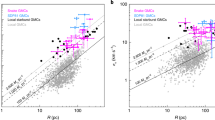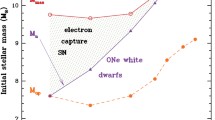Abstract
Fluxes of stars in models of open clusters that are nonstationary in the regular field of the cluster are analyzed. An equilibrium distribution function describes the state of these models from the beginning of their dynamical evolution. Violent relaxation in the open-cluster models proceeds under equilibrium conditions in phase space and does not result in virial equilibrium. The cluster relaxation times in the one-dimensional spaces of a number of stellar-motion parameters are estimated. The stellar fluxes are anisotropic in some two-dimensional parameter spaces. Such open-cluster models exhibit a number of manifestations of self-organization (an energy flux toward the center of the cluster and a transfer of energy from large-scale to small-scale motions, periodic decreases in the entropies of the cluster models with a period equal to that of oscillations of the regular field of the cluster, etc.). It is concluded that violent relaxation represents one form of self-organization in such systems.
Similar content being viewed by others
References
V. M. Danilov, Astron. Zh. 77, 345 (2000) [Astron. Rep. 44, 298 (2000)].
V. M. Danilov, Astron. Zh. 79, 492 (2002) [Astron. Rep. 46, 443 (2002)].
D. Lynden-Bell, Mon. Not. R. Astron. Soc. 136, 101 (1967).
A. A. El-Zant, Astron. Astrophys. 326, 113 (1997).
V. M. Danilov, Astron. Zh. 76, 93 (1999) [Astron. Rep. 43, 74 (1999)].
V. M. Danilov and A. F. Seleznev, Astron. Astrophys. Trans. 6, 85 (1994).
S. Chandrasekar, Principles of Stellar Dynamics (Univ. of Chicago Press, Chicago, 1942; Inostrannaya Literatura, Moscow, 1948).
S. A. Kutuzov and L. P. Osipkov, Astron. Zh. 57, 28 (1980) [Sov.Astron. 24, 17 (1980)].
V. M. Danilov, Astron. Zh. 65, 716 (1988) [Sov. Astron. 32, 374 (1988)].
V. M. Danilov, Astron. Zh. 74, 188 (1997) [Astron. Rep. 41, 163 (1997)].
V. M. Danilov and L. V. Doragavtseva, Astron. Zh. 79, 242 (2002).
V. M. Danilov, Pis'ma Astron. Zh. 23, 365 (1997) [Astron. Lett. 23, 322 (1997)].
I. R. King, Astrophys. J. 67, 471 (1962).
W. C. Saslaw, Gravitational Physics of Stellar and Galactic Systems (Cambridge Univ. Press, Cambridge, 1985; Mir, Moscow, 1989).
M. D. Weinberg, Astrophys. J. 410, 543 (1993).
V. A. Vasil'ev, Yu. N. Romanovskii, and V. G. Yakhno, Autowave Processes [in Russian] (Nauka, Moscow, 1987).
R. Z. Sagdeev, D. A. Usikov, and G. M. Zaslavsky, Nonlinear Physics: from the Pendulum to Turbulence and Chaos (Nauka, Moscow, 1988; Harwood, Chur, 1988).
Author information
Authors and Affiliations
Additional information
__________
Translated from Astronomicheski\(\overset{\lower0.5em\hbox{$\smash{\scriptscriptstyle\smile}$}}{l}\) Zhurnal, Vol. 79, No. 11, 2002, pp. 986–998.
Original Russian Text Copyright © 2002 by Danilov.
Rights and permissions
About this article
Cite this article
Danilov, V.M. Stellar fluxes in numerical dynamical models of open clusters. Astron. Rep. 46, 887–899 (2002). https://doi.org/10.1134/1.1522077
Received:
Accepted:
Issue Date:
DOI: https://doi.org/10.1134/1.1522077




